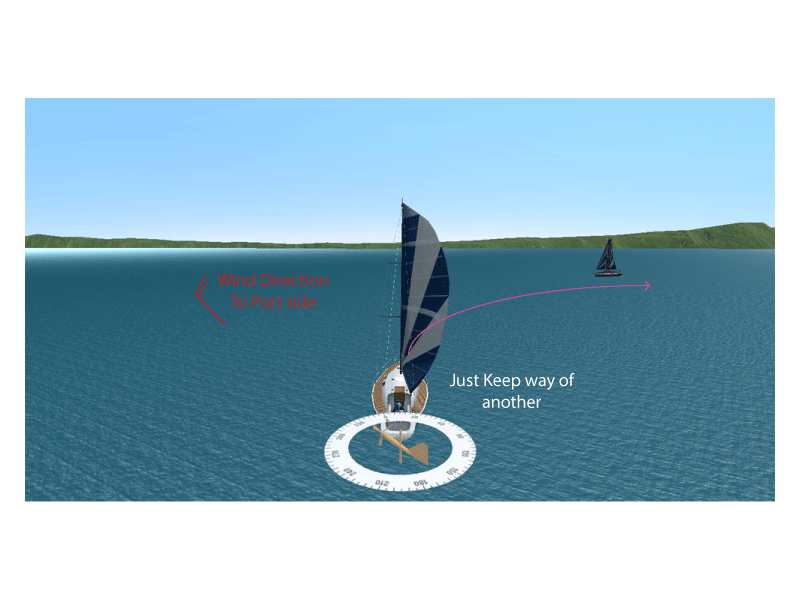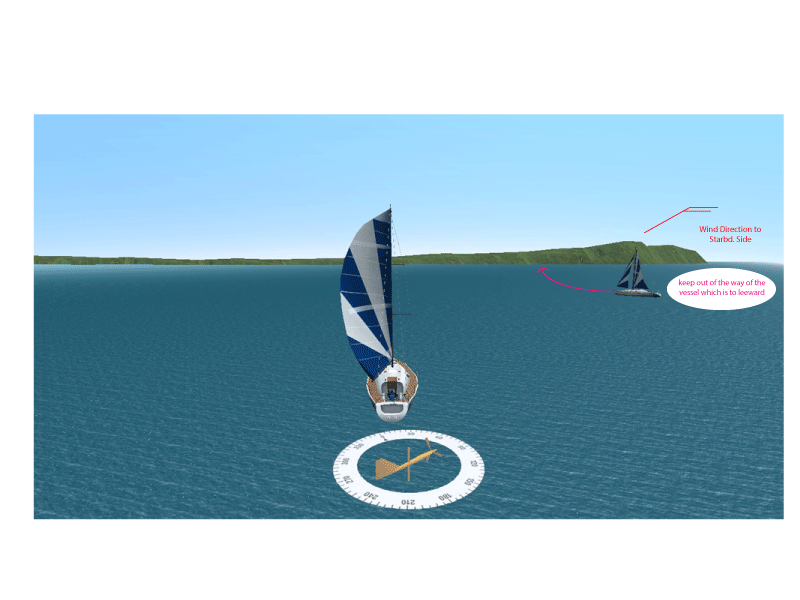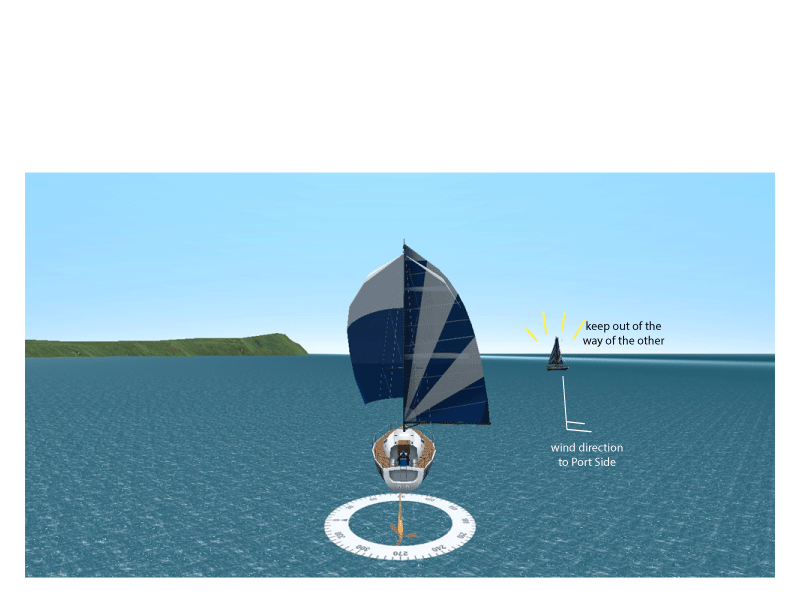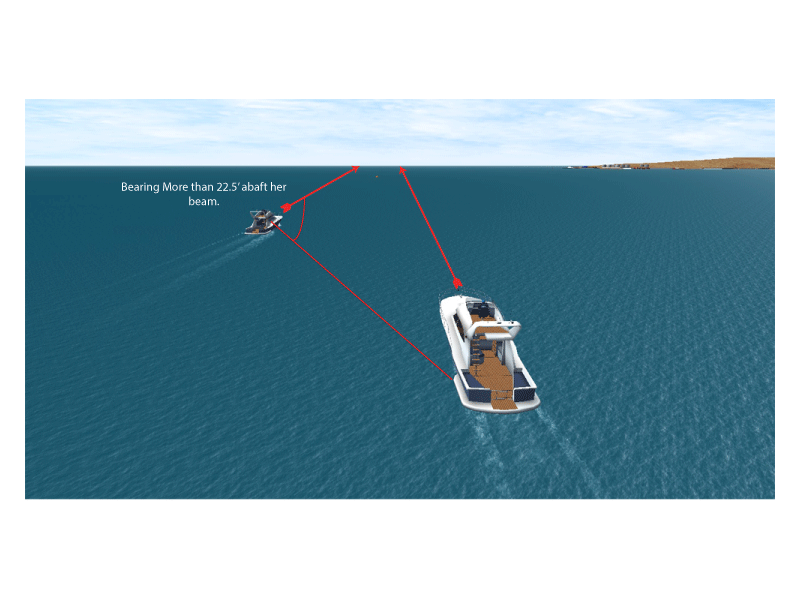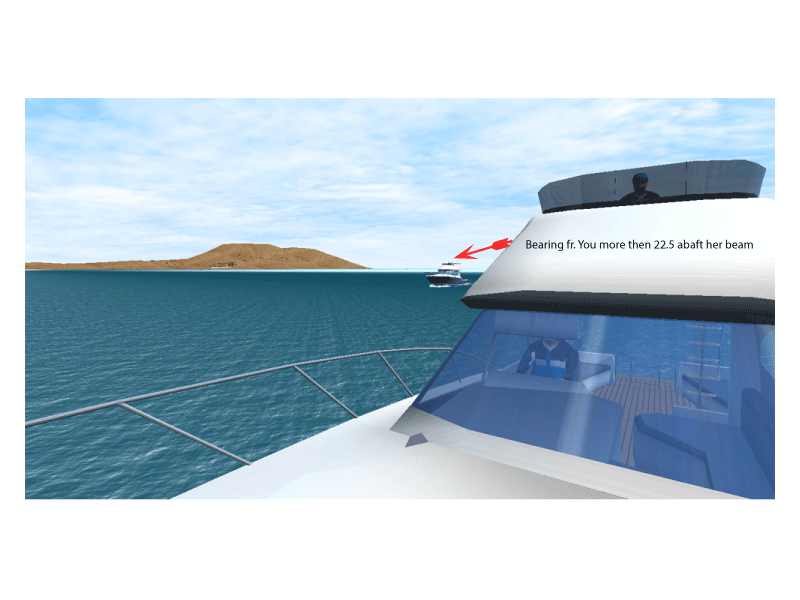Rule 1
Application
States that the rules apply to all vessels upon the high seas and all waters connected to the high seas and navigable by seagoing vessels.
(a). These Rules shall apply to all vessels upon the high seas and in all waters connected therewith navigable by
seagoing vessels.
(b). Nothing in these Rules shall interfere with the operation of special rules made by an appropriate authority for
roadsteads, harbours, rivers, lakes or inland waterways connected with the high seas and navigable by seagoing
vessels. Such special rules shall conform as closely as possible to these Rules.
(c). Nothing in these Rules shall interfere with the operation of any special rules made by the Government of any State
with respect to additional station or signal lights, shapes or whistle signals for ships of war and vessels proceeding
under convoy, or with respect to additional station or signal lights or shapes for fishing vessels engaged in fishing as a
fleet. These additional station or signal lights, shapes or whistle signals shall, so far as possible, be such that they
cannot be mistaken for any light, shape or signal authorized elsewhere under these Rules.
(d). Traffic separation schemes may be adopted by the Organization for the purpose of these Rules.
(e). Whenever the Government concerned shall have determined that a vessel of special construction or purpose
cannot comply fully with the provisions of any of these Rules with respect to the number, position, range or arc of
visibility of lights or shapes, as well as to the disposition and characteristics of sound-signalling appliances, such vessel
shall comply with such other provisions in regard to the number, position, range or arc of visibility of lights or shapes, as
well as to the disposition and characteristics of sound-signalling appliances, as her Government shall have determined
to be the closest possible compliance with these Rules in respect of that vessel.
Rule 2
Responsibility
Covers the responsibility of the master, owner and crew to comply with the rules.
(a). Nothing in these Rules shall exonerate any vessel, or the owner, master or crew thereof, from the consequences of
any neglect to comply with these Rules or of the neglect of any precaution which may be required by the ordinary
practice of seamen, or by the special circumstances of the case.
(b). In construing and complying with these Rules due regard shall be had to all dangers of navigation and collision and
to any special circumstances, including the limitations of the vessels involved, which may make a departure from these
Rules necessary to avoid immediate danger.
Rule 3
General definitions
Includes definitions.
(a). The word “vessel” includes every description of water craft, including non-displacement craft, WIG craft and
seaplanes, used or capable of being used as a means of transportation on water.
(b). The term “power-driven vessel” means any vessel propelled by machinery.
(c). The term “sailing vessel” means any vessel under sail provided that propelling machinery, if fitted, is not being
used.
(d). The term “vessel engaged in fishing” means any vessel fishing with nets, lines, trawls or other fishing apparatus
which restrict manoeuvrability, but does not include a vessel fishing with trolling lines or other fishing apparatus which
do not restrict manoeuvrability.
(e). The word “seaplane” includes any aircraft designed to manoeuvre on the water.
(f). The term “vessel not under command” means a vessel which through some exceptional circumstance is unable to
manoeuvre as required by these Rules and is therefore unable to keep out of the way of another vessel.
(g). The term “vessel restricted in her ability to manoeuvre” means a vessel which from the nature of her work is
restricted in her ability to manoeuvre as required by these Rules and is therefore unable to keep out of the way of
another vessel. The term “vessels restricted in their ability to manoeuvre” shall include but not be limited to:
(i). a vessel engaged in laying, servicing or picking up a navigation mark, submarine cable or pipeline;
(ii). a vessel engaged in dredging, surveying or underwater operations;
(iii). a vessel engaged in replenishment or transferring persons, provisions or cargo while underway;
(iv). a vessel engaged in the launching or recovery of aircraft;
(v). a vessel engaged in mine clearance operations;
(vi). a vessel engaged in a towing operation such as severely restricts the towing vessel and her tow in their ability to
deviate from their course.
(h). The term “vessel constrained by her draught” means a power-driven vessel which, because of her draught in
relation to the available depth and width of navigable water, is severely restricted in her ability to deviate from the
course she is following.
(i). The word “underway” means that a vessel is not at anchor, or made fast to the shore, or aground.
(j). The words “length” and “breadth” of a vessel mean her length overall and greatest breadth.
(k). Vessels shall be deemed to be in sight of one another only when one can be observed visually from the other.
(l). The term “restricted visibility” means any condition in which visibility is restricted by fog, mist, falling snow, heavy
rainstorms, sandstorms or any other similar causes.
(m). The term “Wing-In-Ground (WIG) craft” means a multimodal craft which, in its main operational mode, flies in close
proximity to the surface by utilizing surface-effect action.
Rule 4
Application
Says the section applies in any condition of visibility.
Rules in this section apply in any condition of visibility.
Rule 5
Look Out
Requires that “every vessel shall at all times maintain a proper look-out by sight and hearing as well as by all available means appropriate in the prevailing circumstances and conditions so as to make a full appraisal of the situation and of the risk of collision.
Every vessel shall at all times maintain a proper look-out by sight and hearing as well as by all available means
appropriate in the prevailing circumstances and conditions so as to make a full appraisal of the situation and of the risk
of collision.
Rule 6
Safe Speed
Deals with safe speed. It requires that: “Every vessel shall at all times proceed at a safe speed…”. The Rule describes the factors which should be taken into account in determining safe speed. Several of these refer specifically to vessels equipped with radar.The importance of using “all available means” is further stressed in
Every vessel shall at all times maintain a proper look-out by sight and hearing as well as by all available means
appropriate in the prevailing circumstances and conditions so as to make a full appraisal of the situation and of the risk
of collision.
Rule 7
Risk of collision
covering risk of collision, which warns that “assumptions shall not be made on the basis of scanty information, especially scanty radar information”
(a). Every vessel shall use all available means appropriate to the prevailing circumstances and conditions to determine
if risk of collision exists. If there is any doubt such risk shall be deemed to exist.
(b). Proper use shall be made of radar equipment if fitted and operational, including long-range scanning to obtain early
warning of risk of collision and radar plotting or equivalent systematic observation of detected objects.
(c). Assumptions shall not be made on the basis of scanty information, especially scanty radar information.
(d). In determining if risk of collision exists the following considerations shall be among those taken into account:
(i). such risk shall be deemed to exist if the compass bearing of an approaching vessel does not appreciably change;
(ii). such risk may sometimes exist even when an appreciable bearing change is evident, particularly when approaching
a very large vessel or a tow or when approaching a vessel at close range.
Rule 8
Action to avoid collision
Covers action to be taken to avoid collision.
(a). Any action to avoid collision shall be taken in accordance with the Rules of this Part and shall, if the circumstances
of the case admit, be positive, made in ample time and with due regard to the observance of good seamanship.
(b). Any alteration of course and/or speed to avoid collision shall, if the circumstances of the case admit, be large
enough to be readily apparent to another vessel observing visually or by radar; a succession of small alterations of
course and/or speed should be avoided.
(c). If there is sufficient sea-room, alteration of course alone may be the most effective action to avoid a close-quarters
situation provided that it is made in good time, is substantial and does not result in another close-quarters situation.
(d). Action taken to avoid collision with another vessel shall be such as to result in passing at a safe distance. The
effectiveness of the action shall be carefully checked until the other vessel is finally past and clear.
(e). If necessary to avoid collision or allow more time to assess the situation, a vessel shall slacken her speed or take
all way off by stopping or reversing her means of propulsion.
(i). A vessel which, by any of these Rules, is required not to impede the passage or safe passage of another vessel
shall, when required by the circumstances of the case, take early action to allow sufficient sea-room for the safe
passage of the other vessel.
(ii). A vessel required not to impede the passage or safe passage of another vessel is not relieved of this obligation if
approaching the other vessel so as to involve risk of collision and shall, when taking action, have full regard to the
action which may be required by the Rules of this part.
(iii). A vessel the passage of which is not to be impeded remains fully obliged to comply with the Rules of this part when
the two vessels are approaching one another so as to involve risk of collision.
Rule 9
Narrow Channels
(a). A vessel proceeding along the course of a narrow channel or fairway shall keep as near to the outer limit of the
channel or fairway which lies on her starboard side as is safe and practicable.
(b). A vessel of less than 20 metres in length or a sailing vessel shall not impede the passage of a vessel which can
safely navigate only within a narrow channel or fairway.
(c). A vessel engaged in fishing shall not impede the passage of any other vessel navigating within a narrow channel or
fairway.
(d). A vessel shall not cross a narrow channel or fairway if such crossing impedes the passage of a vessel which can
safely navigate only within such channel or fairway. The latter vessel may use the sound signal prescribed in Rule 34(d)
if in doubt as to the intention of the crossing vessel.
(i). In a narrow channel or fairway when overtaking can take place only if the vessel to be overtaken has to take action
to permit safe passing, the vessel intending to overtake shall indicate her intention by sounding the appropriate signal
prescribed in Rule 34(c)(i). The vessel to be overtaken shall, if in agreement, sound the appropriate signal prescribed in
Rule 34(c)(ii) and take steps to permit safe passing. If in doubt she may sound the signals prescribed in Rule 34(d).
(ii). This Rule does not relieve the overtaking vessel of her obligation under Rule 13.
(f). A vessel nearing a bend or an area of a narrow channel or fairway where other vessels may be obscured by an
intervening obstruction shall navigate with particular alertness and caution and shall sound the appropriate signal
prescribed in Rule 34(e).
(g). Any vessel shall, if the circumstances of the case admit, avoid anchoring in a narrow channel.
Rule 10
Traffic separation schemes
The Rule of the Collision Regulations deals with the behavior of vessels in or near traffic separation schemes adopted by the Organization. By regulation 8 of Chapter V (Safety of Navigation) of SOLAS, IMO is recognized as being the only organization competent to deal with international measures concerning the routeing of ships.
Traffic separation schemes
(a). This Rule applies to traffic separation schemes adopted by the Organization and does not relieve any vessel of her
obligation under any other rule.
(b). A vessel using a traffic separation scheme shall:
(i). proceed in the appropriate traffic lane in the general direction of traffic flow for that lane;
(ii). so far as practicable keep clear of a traffic separation line or separation zone;
(iii). normally join or leave a traffic lane at the termination of the lane, but when joining or leaving from either side shall
do so at as small an angle to the general direction of traffic flow as practicable.
(c). A vessel shall, so far as practicable, avoid crossing traffic lanes but if obliged to do so shall cross on a heading as
nearly as practicable at right angles to the general direction of traffic flow.
(d).
(i). A vessel shall not use an inshore traffic zone when she can safely use the appropriate traffic lane within the
adjacent traffic separation scheme. However, vessels of less than 20 metres in length, sailing vessels and vessels
engaged in fishing may use the inshore traffic zone.
(ii). Notwithstanding subparagraph (d)(i), a vessel may use an inshore traffic zone when en route to or from a port,
offshore installation or structure, pilot station or any other place situated within the inshore traffic zone, or to avoid
immediate danger.
(e). A vessel other than a crossing vessel or a vessel joining or leaving a lane shall not normally enter a separation
zone or cross a separation line except:
(i). in cases of emergency to avoid immediate danger;
(ii). to engage in fishing within a separation zone.
(f). A vessel navigating in areas near the terminations of traffic separation schemes shall do so with particular caution.
(g). A vessel shall so far as practicable avoid anchoring in a traffic separation scheme or in areas near its terminations.
(h). A vessel not using a traffic separation scheme shall avoid it by as wide a margin as is practicable.
(i). A vessel engaged in fishing shall not impede the passage of any vessel following a traffic lane.
(j). A vessel of less than 20 metres in length or a sailing vessel shall not impede the safe passage of a power-driven
vessel following a traffic lane.
(k). A vessel restricted in her ability to manoeuvre when engaged in an operation for the maintenance of safety of
navigation in a traffic separation scheme is exempted from complying with this Rule to the extent necessary to carry out
the operation.
(l). A vessel restricted in her ability to manoeuvre when engaged in an operation for the laying, servicing or picking up
of a submarine cable, within a traffic separation scheme, is exempted from complying with this Rule to the extent
Rule 11
Application
Rules in this section apply to vessels in sight of one another.
Rule 12
Sailing vessels
States action to be taken when two sailing vessels are approaching one another.
(a). When two sailing vessels are approaching one another, so as to involve risk of collision, one of them shall keep out
of the way of the other as follows:
(i). when each has the wind on a different side, the vessel which has the wind on the port side shall keep out of the way of the other;
(ii). when both have the wind on the same side, the vessel which is to windward shall keep out of the way of the vessel which is to leeward;
(iii). if a vessel with the wind on the port side sees a vessel to windward and cannot determine with certainty whether the other vessel has the wind on the port or on the starboard side, she shall keep out of the way of the other.
(b). For the purpose of this Rule the windward side shall be deemed to be the side opposite to that on which the mainsail is carried or, in the case of a square-rigged vessel, the side opposite to that on which the largest fore-and-aft
sail is carried.
Rule 13
Overtaking
Covers overtaking – the overtaking vessel should keep out of the way of the vessel being overtaken.
(a). Notwithstanding anything contained in the Rules of part B, sections I and II, any vessel overtaking any other shall
keep out of the way of the vessel being overtaken.
(b). A vessel shall be deemed to be overtaking when coming up with another vessel from a direction more than 22.5
degrees abaft her beam, that is, in such a position with reference to the vessel she is overtaking, that at night she
would be able to see only the sternlight of that vessel but neither of her sidelights.
(c). When a vessel is in any doubt as to whether she is overtaking another, she shall assume that this is the case and
act accordingly.
(d). Any subsequent alteration of the bearing between the two vessels shall not make the overtaking vessel a crossing
vessel within the meaning of these Rules or relieve her of the duty of keeping clear of the overtaken vessel until she is
finally past and clear.
A vessel shall be deemed to be overtaking when coming up with another vessel from a direction more than 22.5
degrees abaft her beam, that is, in such a position with reference to the vessel she is overtaking, that at night she
would be able to see only the sternlight of that vessel but neither of her sidelights.

